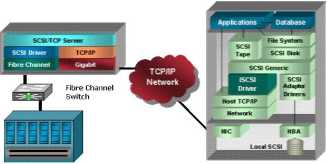9818247289
SAN Security Protocols and Mechanisms
iSCSI enables SCSI-3 commands to be encapsulated in TCP/IP packets and delivered reliably over IP networks. As it sits above the physical and data-link layers, iSCSI interfaces to the operating system's standard SCSI access method command set to enable the access of block-level storage that resides on Fibrę Channel SANs over an IP network via iSCSI-to-Fibre Channel gateways such as storage routers and switches. iSCSI protocol stack building biocks are illustrated in Exhibit 5.

Fibrę Cliannel Storaiie Array
Exhibit 5: iSCSI Solution Architecture
Initial iSCSI deployments were targeted at smali to medium-sized businesses and departments or branch offices of larger enterprises that have not deployed Fibrę Channel SANs yet, however iSCSI is also an affordable way to create IP SANs from a number of local or remote DAS devices. If there is Fibrę Channel present, as it is typically in a data center, it could be also accessed by the iSCSI SANs via an iSCSI-to-Fibre Channel storage routers and switches.
2.4 Fibrę Channel
Fibrę Channel (FC) is an open industry standard serial interface for high-speed Systems. FC is a protocol for transferring the data over fibber cable that consists of multiple layers covering different functions. As a protocol between the host and a storage device, FC was really out of a scope of an average information technology professional for a simple reason that it was point to point connection between the host with a HBA and storage device of typically same vendor which did not require any knowledge or understanding except maybe during the installation process. From the speed perspective, FC is available already in flavors of 1 Gbps and 2 Gbps while specifications for 4Gbps as well as 1 OGbps are being worked on and are not that far away.
FC protocol stack is defined in a standard specification of a Technical Committee Tl 1.3 of an INCITS (InterNational Committee for Information Technology Standards) and is illustrated in Exhibit 6.
Wyszukiwarka
Podobne podstrony:
SAN Security Protocols and Mechanisms 19 An iSCSI node must also support Internet Key Exchange (IKE)
SAN Security Protocols and Mechanisms 10 networks, allowing a commodity IP network to function in a
SAN Security Protocols and Mechanisms 3.3 Access Control and Authentication Another critical aspect
SAN Security Protocols and Mechanisms 12 One host or storage device could also belong to a multiple
SAN Security Protocols and Mechanisms 13 4.1.3 Fibrę Channel Security Protocols To address additiona
SAN Security Protocols and Mechanisms 14 4.1.3.1.2 Fibrę Channel Authentication Protocol Fibrę Chann
SAN Security Protocols and Mechanisms 15 4.1.3.2FC-SP per frame confidentiality and integrity Recogn
SAN Security Protocols and Mechanisms 16 FC-2 Payload: 0-528 Transmission
SAN Security Protocols and Mechanisms 17 • Data Origin Authentication The IPsec re
SAN Security Protocols and Mechanisms endpoints can be determined, the true source and destination e
SAN Security Protocols and Mechanisms_2_ Storage Area Networks Security Protocols and Mechanisms Ind
SAN Security Protocols and Mechanisms 20 6 Futurę directions Storage security is still evolving topi
SAN Security Protocols and Mechanisms Index of Exhibits Exhibit 2: NAS
SAN Security Protocols and Mechanisms Storage Area Networks Security Protocols and Mechanisms 1 Intr
SAN Security Protocols and Mechanisms Storage or shortly NAS. NAS architecture consist of a dedicate
SAN Security Protocols and Mechanisms The invention of a Fibrę Channel (FC) has opened a complete ne
SAN Security Protocols and Mechanisms Exhibit 6: Fibrę Channel Protocol Stack The lowest level (FC-0
SAN Security Protocols and Mechanisms FCIP transports Fibrę Channel data by creating a tunnel betwee
więcej podobnych podstron